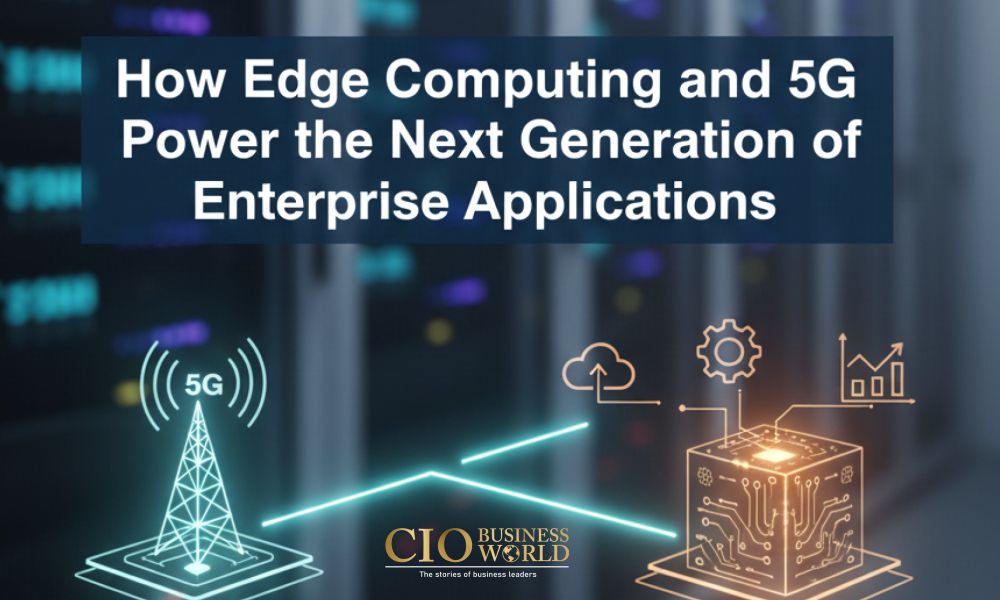Businesses like factories, automobiles, healthcares, retail and logistics all rely on fast reliable data. Delays damage operations also raise costs and risk. That is why 5G and edge computing matter for modern enterprise systems. They move computing closer to devices, which cuts the delay and lets systems work faster.
Old networks sent data far away for processing. Devices talked to central clouds. Each round trip adds time and bandwidth costs. That model does not work well for systems that must respond in milliseconds. 5G and edge computing change that model. They let many decisions happen near the source of the data. They also allow the cloud handle heavy analysis and long-term storage. One such partner is IR Solutions, a remote IoT and cloud-based services company which helps businesses in cloud-based systems.
What edge computing means for modern enterprises
Edge computing runs processing close to the devices that create data. That processing can live in a small data center, at a cell site, in a factory server room, or in a gateway on the local network. The goal is to reduce latency. It also reduces the volume of data sent over the network.
When decisions must be made fast, local processing matters. A vehicle that must brake to avoid a collision cannot wait for a remote cloud to respond. A manufacturing line that inspects parts on a camera feed needs instant results to stop defects. Edge computing handles those needs.
Edge nodes can also filter and summarize data. They send only useful or aggregated information to the central cloud. That lowers bandwidth use and cuts cloud costs. It also reduces the surface area for some security risks, because sensitive raw data can stay local.
The role of 5G in enabling the edge
5G upgrades wireless networks in three ways. It increases speed, raises capacity, and lowers latency. Each matters for enterprise use.
Higher speed moves more data in less time. Higher capacity lets networks support far more connected devices. Lower latency cuts the delay between sending and receiving data to very small values. For real-time applications, latency is essential.
5G networks also support more flexible network design. They allow network slicing. That means a slice of the network can be reserved for a specific application or customer. That makes it easier to guarantee performance for critical services.
How 5G and edge computing work together
Edge computing and 5G are complementary. Edge nodes handle local processing. 5G provides fast links to move key data between devices, edge nodes, and central systems.
● Edge computing processes and filters data locally.
● 5G ensures that the remaining critical data reaches centralized systems quickly.
This combination allows enterprises to run complex systems in real time. Think of an automated warehouse with hundreds of robots coordinating movement. The edge handles local decisions, while 5G connects the system to the cloud for larger analysis and oversight.
Enterprise Applications Powered by 5G and Edge
1- Smart manufacturing
Factories use robots, machine vision, and smart sensors to automate tasks. Edge computing analyzes video and sensor data in real time to catch defects as they occur and reduce downtime.
2- Healthcare
Medical devices and imaging produce large data streams. Edge nodes in hospitals process this data locally for faster diagnostics and remote assistance. 5G keeps mobile care devices reliably connected everywhere.
3- Smart cities
Traffic control, public safety, and energy systems need real-time inputs. Edge computing lets local controllers act fast on sensor data. 5G links controllers to central systems for better coordination.
4- Retail and logistics
Retailers use edge servers to track shoppers and manage stroage in real time. In logistics, 5G connects fleets and warehouses for live updates and smoother deliveries.
5- Media and entertainment
Streaming and live events need low lag and high bandwidth. Edge servers place video near viewers to reduce buffering. 5G supplies needed bandwidth and mobility for live production and distribution.
Key Benefits for Businesses
Reduced latency: Local processing shortens response times for critical systems. That translates into safer operations and faster user experiences.
Lower cost for cloud and bandwidth: Processing data locally reduces the volume sent to central clouds, which cuts cloud compute and storage bills.
Better reliability: Local compute can keep essential services running even when central links are slow or interrupted. It improves uptime for critical applications.
Scalability: Computing Edge and 5G allows businesses add capacity where needed. Companies can scale devices and edge nodes without central upgrades.
Improved privacy controls: Sensitive data can remain within a local network. That helps meet regulatory and compliance requirements.
Challenges for Considerations
While promising, deploying 5G and edge systems requires planning.
Infrastructure Costs
Building or leasing local edge nodes and integrating them with 5G networks involves capital investment.
System Compatibility
Not all devices or platforms work seamlessly together. Businesses must ensure compatibility across outsourcing partners and technologies.
Data Governance
With more data processed at the edge, policies for storage, access, and protection must be clearly defined.
The Role of Cloud and IoT in This Ecosystem
– Edge computing doesn’t replace the cloud, it complements. Data that needs deep analysis or long-term storage still moves to centralized clouds.
– The IoT acts as the connector, collecting data from sensors, vehicles, or machines and sending it to edge servers for immediate action. 5G ensures this data moves fast and reliably.
Companies that manage this balance effectively can turn real-time data into real-time insights. Use Cases
● Automotive: Cars need instant response for safety and coordination. Edge computing manages sensors nearby, while 5G connects them for maps and traffic.
● Energy: Energy grids use localized control to balance supply and demand. Edge systems respond to local fluctuations. 5G links distributed energy resources for coordinated control.
● Telecommunications: Telecom providers run virtual network functions at edge sites to offer services with better performance for enterprise clients. That reduces latency and allows operators to launch new offerings faster.
● Retail: Retail stores use local edge servers to manage cameras and point-of-sale data. The edge runs analytics that tailor promotions in real time, while the cloud stores sales data for deeper reporting.
Each of these examples shows how edge and 5G reshape traditional operations. Remote Edge Services
Modern enterprises often need partners to implement these technologies. Setting up and managing edge infrastructure, IoT networks, or hybrid clouds requires both expertise and remote capabilities.
IR Solutions helps companies bridge this gap. As a remote development company offering IoT and cloud-based services also supports businesses building next-generation platforms that rely on fast, secure data movement. From custom software to connected device management, their teams ensure that edge and cloud systems work smoothly across geographies.
This approach lets companies deploy secure applications faster and maintain continuous operations without needing large in-house teams.
Conclusion
5G and edge computing move data processing from distant clouds to nearby devices. They reduce delay and give better control. They let enterprises run applications that were not possible
before. The shift affects both technology and operations. Success requires a clear strategy, careful architecture, strong security, and reliable partners. IT development companies provide IoT and cloud based services to help teams design and run these systems. That support speeds deployment and keeps operations steady across locations.









